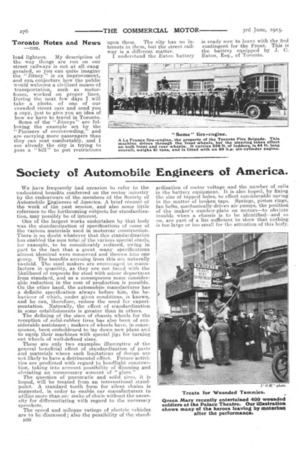Society of Automobile Engineers of America.
Page 12

If you've noticed an error in this article please click here to report it so we can fix it.
We have frequently had occasion to refer to the undoubted benefits conferred on the motor industry by the endeavours of the members of the Society of Automobile ngineersof America. A brief resume of the work of the past session, and also some little reference to the forthcoming subjects for standardization, may possibly be of interest.
One of the largest works undertaken by that body was the standardization of specifications of some of the various materials used in motorcar construction. There is no doubt whatever that this standaidization has enabled the sum total of the various special steels, for example, to be considerably reduced, owing in part to the fact that a great many specifications almost identical were conserved and thrown into, one group. The benefits accruing from this are naturally twofold.. The steel makers are encouraged to manufacture in quantity, as they are not faced with the likelihood of requestAs for steel with minor departures from standard, and as a consequence some considerable reduction in the cost of production is possible. On the other hand, the automobile manufacturer has a definite specification always before him, the behaviour of which, under given conditions, is known, and he can, therefore; reduce the need for experimentation. Naturally, the effect of standardization in some establishments is greater than in others. The defining of the sizes of chassis wheels for the reception of solid-rubber tires has also been of considerable assistance ; makers of wheels have, in consequence been emboldened to lay down new plant and to equip their machines with special jigs for turning out wheels of well-defined sizes.
These are only two examples illustrative of the general beneficial effect of standardization of parts and materials where such limitations of design are not likely to have a detrimental effect. Future activities are predicted with regard to headlight construction, taking into account possibility of dimming and obviating an unnecessary amount of "glare." The question of pneumatic and solid tires, it is hoped, will be treated from an international standpoint. A standard.. tooth form for silent chains is -suggested, in order to enable . car manufacturers to -utilize more than onc make of chain without the neces, sity for differentiating with regard to the necessary 'sprockets.
The speed and mileage ratings of electric vehicles are to be discussed ; also the possibility of the stand ardization of motor voltage and the number of cells in the battery equipment. It is also hoped, by fixing the size of tapped holes, to effect considerable saving in the matter of broken taps. Springs, piston rings, fan belts, mechanically-driven air pumps, the position of the maker's number-plate on motors—to obviate trouble when a chassis is to be identified—and so on, are part of a list sufficient to show that nothing is too large or too small for the attention of this body.




















